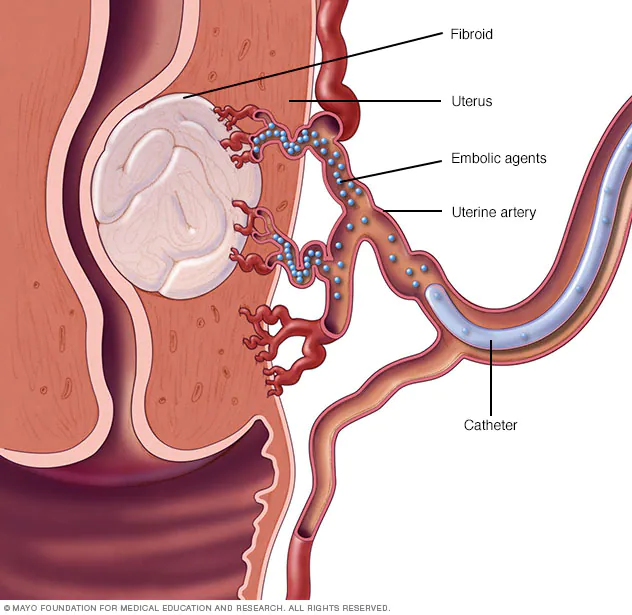Uterine Artery Embolisation for Adenomyosis
Adenomyosis is a condition where the lining of the womb extends abnormally deep into the uterus.
Adenomyosis causes heavy and prolonged bleeding. The heavy bleeding caused by fibroids can lead to tiredness, fatigue, and low energy due to iron deficiency anemia. Severe pain from adenomyosis also can severely affect the quality of life and sexual function.
Uterine Artery Embolisation is the same procedure used to treat fibroids, and is sometimes referred to as Uterine Fibroid Embolisation.

Image credit: Mayo Clinic
What is Uterine Artery Embolisation (UAE)?
Uterine artery embolisation (often referred to uterine fibroid embolisation) is generally done under sedation and a local anaesthetic. This may make UAE a viable option for women who can’t have the general anaesthetic used for more invasive treatments.
Following sedation, an interventional radiologist will insert a tiny catheter through the wrist or groin and manoeuvre it into the uterine artery under X-ray guidance. Tiny particles are then injected into the arteries supplying the adenomyotic tissue, reducing their blood flow and causing it to shrink over time. The whole procedure takes about 90 minutes. No abdominal incisions or scars are made, and no stitches are needed.
After the procedure, you will need to remain in the hospital overnight. If you can eat and drink normally in the morning and your pain is controlled, you can go home.
Do I Need Treatment?
Only patients who are symptomatic need treatment. The majority of women with adenomyosis will not be symptomatic. When they occur however symptoms can be debilitating. If you are concerned by any of the following then you may wish to consider treatment:
- Heavy bleeding with frequent changes of pads
- Having to wear double pads
- Passing large clots
- Tiredness due to anaemia
- Concerns over periods limit your work, social life or normal activities
How is Adenomyosis Managed?
Adenomyosis can be managed or treated in a few ways:
- Medically – for example using contraceptive medication to control bleeding symptoms. Anti-inflammatory medications can also be used for pain.
- Surgically – options include endometrial ablation or hysterectomy. For more focal collections of adenomyosis (known as adenomyoma) there may also be other surgical options. Hysterectomy, removal of the entire uterus is a definitive treatment for symptoms but comes with the risks of anaesthesia and surgery as well as of course preventing further pregnancy.
- Uterine Artery Embolisation – this minimally invasive approach is almost identical UFE performed for uterine fibroids. This allows significant symptom control in a majority of patients and can prevent the need for hysterectomy.

The first line treatment option is medical management. Undoubtedly symptoms are best managed by an individual patient-centred approach and some women would be best served by surgery and others by embolisation. When you are seen in rooms by the IR specialist you can trust that you will be offered treatment only if it is thought to be the best option for you as an individual.
What are the Benefits of Uterine Artery Embolisation?
As UAE is a non-surgical treatment option, it has a range of benefits that traditional management of adenomyosis does not provide:
- It’s safer than other alternatives – Current evidence and clinical study show that the risk of major complications is lower for UAE than other surgical fibroid treatment options.
- It’s effective – clinical studies have shown that UAE provides lasting relief from symptoms in over 80% of women.
- It doesn’t preclude other treatments (if required) – For those who remain symptomatic, surgical options remain possible after UAE.
- Its recovery period is shorter – since surgical incisions aren’t used and damage to the body’s tissues is minimised, recovery is usually much quicker compared to invasive surgery methods.
- Your uterine remains intact - while it is true that hysterectomy is the 'gold standard' for adenomyosis treatment, losing the ability to fall pregnant means it is not suitable for everyone. UAE treats adenomyosis and keeps your uterine intact.
What is Recovery Like?
Following the procedure, you'll need to stay in the hospital overnight, with most women being able to go home the following morning if their pain is under control.
The pain is usually the worst in the first 12 hours, and it's quite common for you to feel nauseous and have no appetite, although you are allowed to eat and drink. During this time you'll be provided with pain medication.
In the morning, you'll have your bladder catheter removed, be allowed to walk around and have a shower. You'll be provided with take-home medication including Panadol and nonsteroidal anti-inflammatory drugs.
Once home you'll need to take it easy for a few days and may feel tired and lethargic. After about 5 days you should feel well enough to venture outside, and after approximately 7 days you can return to work and regular activities.
How Successful is Uterine Artery Embolisation?
Uterine Artery Embolisation for adenomyosis is very successful - one long-range study found that "UAE is a durable, definitive treatment for adenomyosis in 80% of women. Hysterectomies were avoided in 93% of women. UAE did not bring forward menopause. UAE should be offered to women in whom conservative management for adenomyosis has failed, as a less invasive alternative to hysterectomy."
UAE is, therefore, a suitable solution for women looking to cure adenomyosis without major surgery, while also keeping alive the possibility of childbirth.
Will I Still Get My Period After Uterine Artery Embolisation?
Short-term loss of periods may occur in a small number of women, approximately 5-10%. Younger patients usually get their period again 6 months after having the procedure.
Can I Get Pregnant After Having Uterine Artery Embolisation?
The link between adenomyosis and fertility is still unclear, and much more research is needed to definitively link the two. However, from the research available, it is clear that a link does exist, although the cause and reason have yet to be truly understood.
Despite this, the authors of a meta-analysis did recommend either surgical (such as uterine artery embolisation) or medically with the use of Gonadotropin hormone-releasing hormone (also known as GnRH, which stimulates the production of estrogen and progesterone) to improve fertility outcomes.
However, while UAE is a uterus-saving treatment option, it has yet to be shown as fertility-enhancing, and women looking to have UAE to improve their chances of falling pregnant should also speak with their fertility expert.
Further Information
For more information on Uterine Artery Embolisation, including how the procedure is done, details on recovery time, benefits vs risks, and more, head over to our Uterine Fibroid Embolisation page.
Safe, effective treatments with less pain and quicker recovery.
Ensure you know all your options prior to invasive surgical treatment, schedule a consult with Dr Shaun Quigley.


